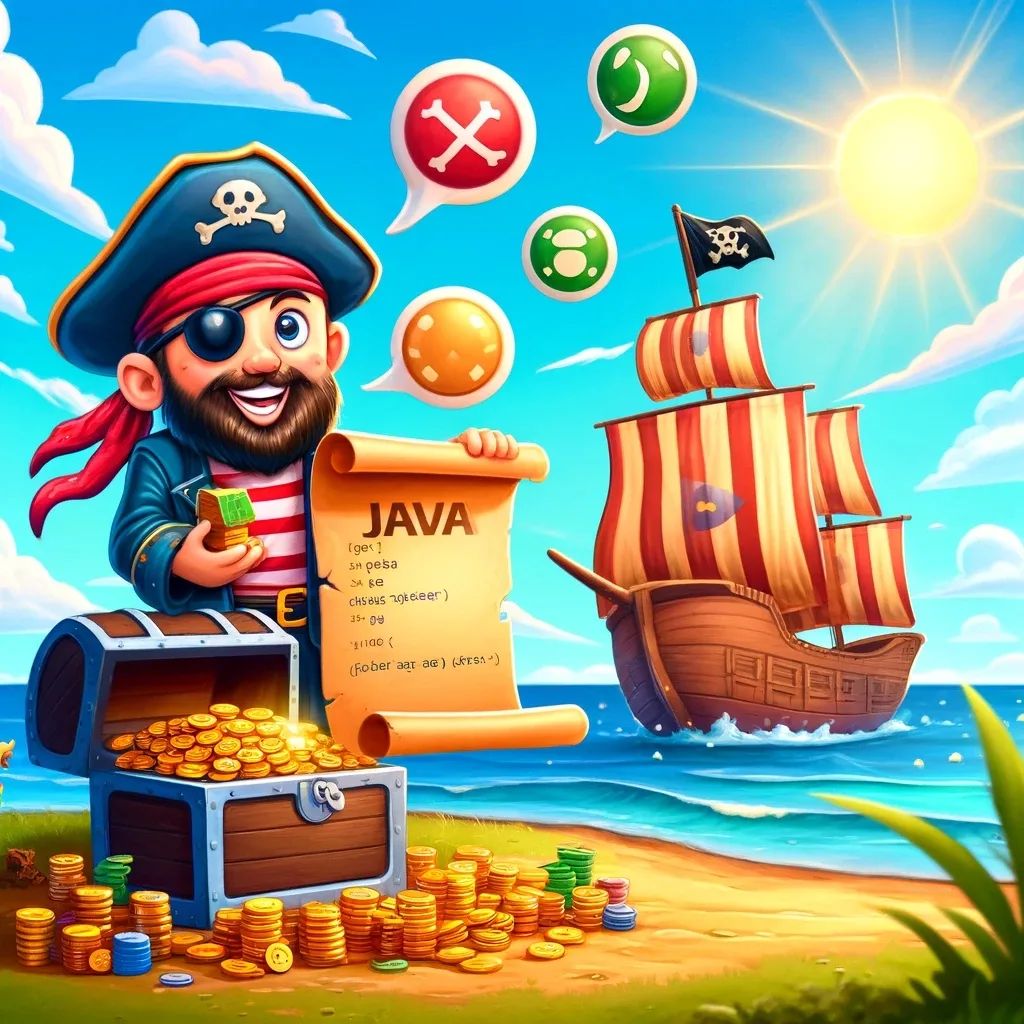
Lesson 2: Variables and Data Types – The Building Blocks of Your Java Adventure
Welcome back, brave Java adventurer! 🎉 Now that you’ve dipped your toes into the world of Java with a friendly “Hello, World!”, it’s time to dive a little deeper. Today, we’ll explore variables and data types—the foundation of pretty much everything you’ll ever do in Java. Think of them as the bricks and mortar of your code castle. Ready to become a Java architect? Let’s get started!
What’s the Deal with Variables?
Imagine you’re a pirate. (Stay with me here.) You’re off searching for treasure, but you need a place to store all the gold you find—otherwise, you’re just going to drop it all over the place. Variables in Java are like treasure chests. They store your data so you can use it later. And just like a treasure chest, each variable has a name (so you can remember where you put your loot) and can hold different types of treasure (or in this case, different types of data).
How to Declare a Variable
In Java, declaring a variable is as easy as saying, “I claim this land in the name of the Queen!” Only instead of land, you’re claiming a piece of memory. Here’s how it works:
int myTreasure = 100;
String treasureMap = "X marks the spot";
boolean isPirate = true;
In this little pirate tale:
int myTreasure = 100;declares an integer variable that stores a number (in this case, 100 gold coins).String treasureMap = "X marks the spot";declares a string variable that stores text (because every pirate needs a treasure map).boolean isPirate = true;declares a boolean variable that stores a true/false value (because either you’re a pirate or you’re not).
Data Types – The Different Types of Treasure
Just like there are different types of treasure (gold coins, jewels, that one mysterious relic nobody knows what to do with), there are different types of data in Java. Here’s a breakdown:
Primitive Data Types
- int: For whole numbers like 42 (or the number of gold coins in your pirate stash).
- double: For numbers with decimal points like 3.14 (because every pirate ship needs a pie chart, right?).
- boolean: For true/false values, like
isPirate = true;. - char: For single characters like ‘A’ (possibly the first letter of your pirate name?).
- byte: For small whole numbers from -128 to 127 (useful when you’re counting something small, like doubloons).
- short: For whole numbers from -32,768 to 32,767 (perhaps the number of islands you’ve explored).
- long: For huge whole numbers from -2^63 to 2^63-1 (perfect for tracking all your pirate treasure).
- float: For fractional numbers with less precision than double (good for tracking the number of rum bottles left on the ship).
Non-Primitive Data Types
Non-primitive types store objects and include more complex types of data:
- String: For text, like “Ahoy, matey!” Strings are your go-to for anything involving words, treasure maps, or pirate jokes.
- Arrays: To store multiple values in a single variable, like an array of all your treasure locations.
- Classes: These allow you to define your own data types. It’s like creating your own pirate crew—each member (object) has unique traits.
- Interfaces: Think of them as a pirate code—an agreement on what methods a class should have, but leaving the details up to each class.
Why Should You Care?
Good question! Without understanding data types, your variables will be all over the place—like treasure scattered across the ocean. Java needs to know what kind of data you’re working with so it can handle it properly. If you try to store a string in an integer variable, Java will throw a fit and refuse to run your program. So, let’s keep things organized!
How to Use Variables in Your Code
Let’s put these variables to good use and bring your pirate adventure to life! Here’s a quick example:
public class PirateAdventure {
public static void main(String[] args) {
int goldCoins = 100;
String shipName = "The Black Pearl";
boolean isCaptain = true;
System.out.println("Welcome aboard " + shipName + "!");
System.out.println("You have " + goldCoins + " gold coins.");
if (isCaptain) {
System.out.println("Ahoy, Captain! You’re in charge.");
} else {
System.out.println("You’re just a deckhand. Better start scrubbing the deck!");
}
}
}
What’s Happening Here?
- We declared three variables:
goldCoins,shipName, andisCaptain. - Then, we printed a little pirate introduction using those variables. Notice how we combined strings and variables with the
+sign. - Finally, we used an
ifstatement to check if the user is the captain. If true, they’re in charge. If not, they’d better grab a mop!
Recap
So, what did we learn today? Variables are your storage containers, and data types are the different kinds of information you can store in those containers. Without them, your code would be like a pirate without a map—lost and confused!
Quick Tips:
- Always declare a data type when creating a variable (Java likes to know what it’s dealing with).
- Use meaningful names for your variables (you wouldn’t name your treasure chest “box”, would you?).
- Don’t mix data types inappropriately (Java will get cranky if you try).
That’s it for Lesson 2! 🎉 You’ve successfully learned how to store and manage data in Java. Next time, we’ll explore control structures (fancy word for making decisions in code). Prepare to feel even more like a coding pirate, navigating the seas of logic!
Stay tuned, and don’t forget your pirate hat for the next lesson!
Ready for the next step? Jump to Lesson 3: Control Structures and keep the adventure going!
See also
- Lesson 2 – Loops and Conditionals: Making Decisions and Repeating Yourself (Without Going Crazy)
- Unlock the Power of JavaScript – A Beginner’s Journey (No Cape Required)
- Lesson 1: Hello, Java! (And No, It’s Not Just Coffee)
- Ready to Master Java? (And No, We're Not Talking About Coffee Beans!)
- Tabs vs. Spaces: The Great Divide in Programming